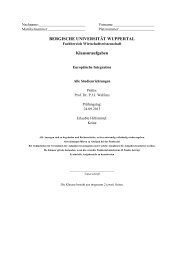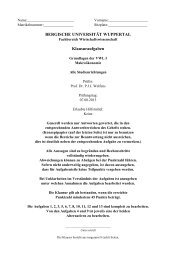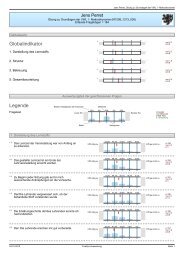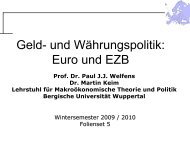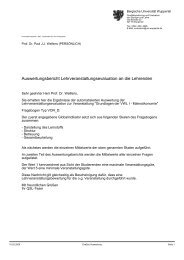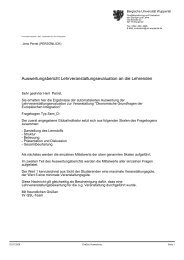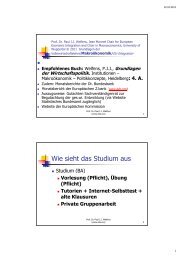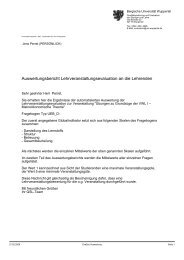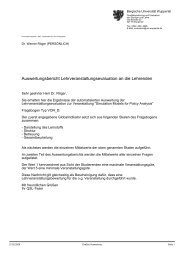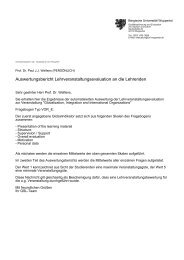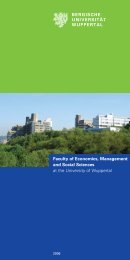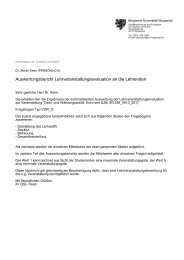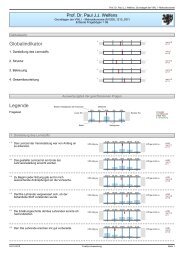UNIVERSITÄT POTSDAM - Prof. Dr. Paul JJ Welfens
UNIVERSITÄT POTSDAM - Prof. Dr. Paul JJ Welfens
UNIVERSITÄT POTSDAM - Prof. Dr. Paul JJ Welfens
Create successful ePaper yourself
Turn your PDF publications into a flip-book with our unique Google optimized e-Paper software.
Tab 9: Sources of Growth in the Business Sector, Germany 1961 - 1990<br />
Source Average annual percentage changes<br />
61 - 90 61 - 65 66 - 70 71 - 75 76 - 80 81 - 85 86 - 90<br />
k t 1.5 2.5 1.9 1.8 1.1 0.8 1.0<br />
l t 0.2 0.7 0.1 -0.6 0.5 -0.6 1.1<br />
pat t−2 0.1 0.3 0.2 -0.3 0.2 0.1 0.3<br />
lex t 0.3 0.4 0.3 0.3 0.0 0.0 0.8<br />
tc t 1.1 1.2 1.7 1.2 1.3 0.7 0.7<br />
Total:<br />
fitted 3.3 5.2 4.3 2.3 3.2 0.9 4.0<br />
realized 3.3 5.2 4.4 1.7 3.6 1.1 3.8<br />
Note: Differences between the sums of the individual components of the growth rates and the fitted total<br />
growth rates are caused by rounding up and down and by joint effects.<br />
Due to the approximation of different sources or causes of technical progress and of<br />
information and communication by means of appropriate indicator variables, it was<br />
then possible to assess, at least roughly, the effects of these variables as well as of the<br />
usual production factors on the growth of real gross value-added. The results of the expost<br />
forecasts of average annual growth rates for the whole observation period as well<br />
as for different subperiods are reported in Table 9. The comparison of the realized total<br />
and the forecasted total growth rates of real gross value-added in the business sector<br />
without agriculture, forestry, and fishing and without housing rental shows a good fitting<br />
of the model to the observed data. Only in the first half of the seventies when the<br />
first oil price crisis takes place does the model overestimate the growth rate by 0.6 percentage<br />
points. Partly to even things out, the model underestimates growth by 0.4 percentage<br />
points in the second half of the seventies.<br />
Turning to the individual factors, it can be seen that the development of the<br />
capital stock has the greatest impact on the growth rates of gross value-added in most<br />
cases, accounting for 0.8 to 2.5 percentage points. This result is in accord with the results<br />
for other countries (cf. BUDD / HOBBIS, 1989a, BUDD / HOBBIS, 1989b and<br />
COE / MOGHADAM, 1993). The influence of telephone calls (as an indicator for information<br />
and communication) is in second position, accounting for 0.7 to 1.7 percentage<br />
points of the average annual growth rates. Here, it must be stressed, that even in<br />
phases of low growth rates this influence was a substantial engine of the remaining<br />
economic growth. The impact of the factor labor on economic growth is strongly influenced<br />
by fluctuations of the number of employees due to business cycles. Especially<br />
the reductions of the number of employees after the first and second oil price crises had<br />
negative impacts on economic growth. On the other hand, the strong increase of the<br />
39



